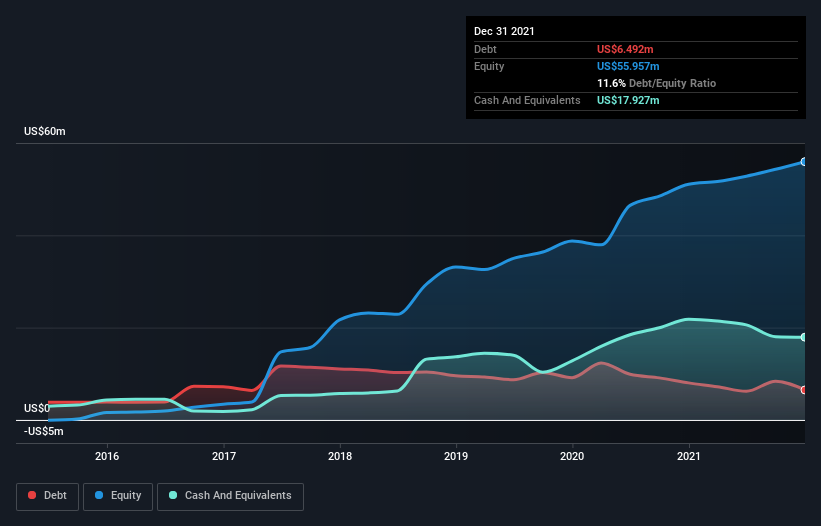Does Hamilton Thorne (CVE:HTL) Have A Healthy Balance Sheet?
Some say volatility, rather than debt, is the best way to think about risk as an investor, but Warren Buffett famously said that 'Volatility is far from synonymous with risk.' So it seems the smart money knows that debt - which is usually involved in bankruptcies - is a very important factor, when you assess how risky a company is. Importantly, Hamilton Thorne Ltd. (CVE:HTL) does carry debt. But the more important question is: how much risk is that debt creating?
When Is Debt A Problem?
Generally speaking, debt only becomes a real problem when a company can't easily pay it off, either by raising capital or with its own cash flow. In the worst case scenario, a company can go bankrupt if it cannot pay its creditors. However, a more common (but still painful) scenario is that it has to raise new equity capital at a low price, thus permanently diluting shareholders. Of course, the upside of debt is that it often represents cheap capital, especially when it replaces dilution in a company with the ability to reinvest at high rates of return. When we examine debt levels, we first consider both cash and debt levels, together.
Check out our latest analysis for Hamilton Thorne
What Is Hamilton Thorne's Debt?
You can click the graphic below for the historical numbers, but it shows that Hamilton Thorne had US$6.49m of debt in December 2021, down from US$8.03m, one year before. However, its balance sheet shows it holds US$17.9m in cash, so it actually has US$11.4m net cash.
A Look At Hamilton Thorne's Liabilities
Zooming in on the latest balance sheet data, we can see that Hamilton Thorne had liabilities of US$10.5m due within 12 months and liabilities of US$8.64m due beyond that. Offsetting this, it had US$17.9m in cash and US$5.19m in receivables that were due within 12 months. So it actually has US$4.01m more liquid assets than total liabilities.
This short term liquidity is a sign that Hamilton Thorne could probably pay off its debt with ease, as its balance sheet is far from stretched. Simply put, the fact that Hamilton Thorne has more cash than debt is arguably a good indication that it can manage its debt safely.
In addition to that, we're happy to report that Hamilton Thorne has boosted its EBIT by 46%, thus reducing the spectre of future debt repayments. There's no doubt that we learn most about debt from the balance sheet. But it is future earnings, more than anything, that will determine Hamilton Thorne's ability to maintain a healthy balance sheet going forward. So if you want to see what the professionals think, you might find this free report on analyst profit forecasts to be interesting.
But our final consideration is also important, because a company cannot pay debt with paper profits; it needs cold hard cash. While Hamilton Thorne has net cash on its balance sheet, it's still worth taking a look at its ability to convert earnings before interest and tax (EBIT) to free cash flow, to help us understand how quickly it is building (or eroding) that cash balance. Happily for any shareholders, Hamilton Thorne actually produced more free cash flow than EBIT over the last three years. That sort of strong cash conversion gets us as excited as the crowd when the beat drops at a Daft Punk concert.
Summing up
While it is always sensible to investigate a company's debt, in this case Hamilton Thorne has US$11.4m in net cash and a decent-looking balance sheet. And it impressed us with free cash flow of US$3.4m, being 115% of its EBIT. So we don't think Hamilton Thorne's use of debt is risky. There's no doubt that we learn most about debt from the balance sheet. But ultimately, every company can contain risks that exist outside of the balance sheet. For instance, we've identified 1 warning sign for Hamilton Thorne that you should be aware of.
At the end of the day, it's often better to focus on companies that are free from net debt. You can access our special list of such companies (all with a track record of profit growth). It's free.
Have feedback on this article? Concerned about the content? Get in touch with us directly. Alternatively, email editorial-team (at) simplywallst.com.
This article by Simply Wall St is general in nature. We provide commentary based on historical data and analyst forecasts only using an unbiased methodology and our articles are not intended to be financial advice. It does not constitute a recommendation to buy or sell any stock, and does not take account of your objectives, or your financial situation. We aim to bring you long-term focused analysis driven by fundamental data. Note that our analysis may not factor in the latest price-sensitive company announcements or qualitative material. Simply Wall St has no position in any stocks mentioned.

 Yahoo Finance
Yahoo Finance 
